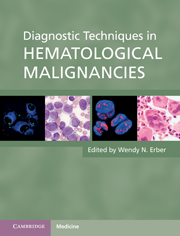Book contents
- Frontmatter
- Contents
- List of Contributors
- Preface
- Part 1 Diagnostic techniques
- Part 2 Hematological malignancies
- 6 The integrated approach to the diagnosis of hematological malignancies
- 7 Acute lymphoblastic leukemia
- 8 Acute myeloid leukemia
- 9 Mature B-cell leukemias
- 10 Mature T-cell and natural-killer cell leukemias
- 11 Lymphoma
- 12 Plasma cell neoplasms
- 13 Chronic myeloid leukemia
- 14 Myeloproliferative neoplasms
- 15 Myelodysplastic syndromes and myelodysplastic/myeloproliferative neoplasms
- Index
- References
7 - Acute lymphoblastic leukemia
from Part 2 - Hematological malignancies
Published online by Cambridge University Press: 06 December 2010
- Frontmatter
- Contents
- List of Contributors
- Preface
- Part 1 Diagnostic techniques
- Part 2 Hematological malignancies
- 6 The integrated approach to the diagnosis of hematological malignancies
- 7 Acute lymphoblastic leukemia
- 8 Acute myeloid leukemia
- 9 Mature B-cell leukemias
- 10 Mature T-cell and natural-killer cell leukemias
- 11 Lymphoma
- 12 Plasma cell neoplasms
- 13 Chronic myeloid leukemia
- 14 Myeloproliferative neoplasms
- 15 Myelodysplastic syndromes and myelodysplastic/myeloproliferative neoplasms
- Index
- References
Summary
Introduction
Acute lymphoblastic leukemia (ALL), also known as lymphoblastic leukemia/lymphoma in the WHO classification, is a malignant expansion of immature lymphoid cells that results from multi-step genetic changes in a single lymphoid progenitor cell. Its incidence peaks between the ages of 2 and 4 years; rates are lower during later childhood, adolescence and young adulthood but the incidence rises in the sixth decade, reaching a second, smaller peak in the elderly. ALL is the most common malignancy diagnosed in patients younger than 15 years. Childhood ALL appears to have a prenatal origin in many cases. In the case of identical twins, when leukemia occurs in one twin, there are a 20% probability that it will also occur in the other twin due to ALL transfer through the placental circulation. In identical twins with the t(4;11); (q21;q23) MLL-AFF1, the chances of ALL becoming clinically overt in the other twin in a short period of time are nearly 100%. The concordance rate in twins is lower in cases of ALL with the ETV6-RUNX1 fusion or T-cell phenotype, probably because of the requirement for additional genetic events for leukemic transformation.
A small proportion of patients (< 5%) have hereditary genetic abnormalities that predispose to the disease, including Down syndrome, ataxia telangiectasia and Bloom's syndrome; children with Down syndrome have a 10- to 30-fold higher risk of developing ALL.
- Type
- Chapter
- Information
- Diagnostic Techniques in Hematological Malignancies , pp. 127 - 145Publisher: Cambridge University PressPrint publication year: 2010



